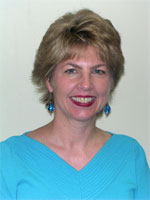Teacher says
UF study: Effective teacher collaboration
requires different strokes for different folks
GAINESVILLE, FL — “Underwear.”

Dr. Mary Brownell
By uttering that single evocative word, Jacksonville elementary school teacher Sarah Edmonds hooks every student in her third-grade class and reels them into her lesson on cause-and-effect, a key principle of reading comprehension.
“Yuck.”
The young students respond in unison, just as Edmonds (not her real name) predicted they would, letting her demonstrate how her one-word monologue was a cause and the students’ “yucky” response was an effect. Because the students also find her example humorous, they give the veteran teacher their full attention.
Edmonds then switches off the lights in the classroom, and the students buzz, “ohhh.” Another cause-and-effect example, and her lesson continues on, the enthralled students hanging on every sentence.
University of Florida College of Education researchers view Edmonds’ lesson strategy—making a potentially boring and complex topic relevant and interesting to children—as characteristic of a knowledgeable teacher who is willing to adopt better teaching strategies and incorporate them into her instruction.
Edmonds’ real name isn’t divulged, nor is the name of her school, because she was one of eight teachers at two high-poverty Jacksonville elementary schools participating anonymously in a federally funded study so their experiences could be freely and openly reported. UF special-education researchers were examining how teachers who readily adopt instructional innovations acquired in teacher study groups, professional development schools and other collaborative arrangements differ from those who don’t.
“In special education, professional collaboration is viewed as a powerful tool for helping teachers serve students with disabilities. Teachers learning and working together to improve their instructional practices is considered a central element of major school reform efforts,” said Mary Brownell, professor in special education and the lead investigator in the UF study. “But there is little in-depth information about why some teachers readily adapt and adopt new, research-based innovations that can change their instructional practices in important ways, while others teachers are less inclined to do so.”
Brownell’s co-investigators in the study were UF education researchers Alyson Adams, Paul Sindelar and Nancy Waldron, and Stephanie vanHover from the University of Virginia. The team included specialists in both special and general education and school psychology. Their research report appears in the current edition (Winter 2006, Vol. 72, Issue 2) of Exceptional Children, the quarterly special-education journal of the Council for Exceptional Children.
Their investigation is part of a larger, federally funded study designed to use collaborative teacher learning—in a school-based group called Teacher Learning Cohort—to promote better teaching of struggling learners and students with disabilities.
“We wanted to know what personal qualities enable some teachers to benefit more than others from professional collaboration,” Brownell said. “This could influence how professional development programs and teacher collaboration arrangements should be structured and tailored so everyone benefits.”
Over the past three school years, UF researchers observed the eight teachers instruct in their classrooms and regularly met with them to provide feedback, examine their personal teaching practices and beliefs and discuss research-proven practices they might want to incorporate into their classroom teaching for helping disabled students and high-risk learners.
“We didn’t expect that teachers would differ so strongly in their ability to use classroom strategies acquired in their collaborative learning groups,” Brownell said.
The researchers identified five personal characteristics that influenced teachers’ willingness to adopt new teaching innovations:
- Most knowledgeable. Sarah Edmonds and the two other teachers classified as “high adopters” of new methods were consistently the most knowledgeable teachers. They quickly grasped how new ideas presented could fit within their curriculum and demonstrated the most effective instructional technique. (Three of the eight teachers were judged “moderate adopters” who used certain classroom practices and ignored others. The two “low adopters,” while supportive of the learning-cohort group, were less inclined to try new strategies or did so only after realizing the methods in use weren’t working well.)
- Teach positive behavior. Well-designed instruction goes a long way towards eliminating behavior problems in the classroom, or so the high adopters believe. They also considered teaching positive behavior to be as important as teaching academics, while other teachers often failed to recognize the importance of actively teaching students more appropriate behavior.
- Student-focused. Teachers most likely to adopt new teaching innovations had the strongest student-centered views of instruction, considering both the academic and behavioral needs of the class and individual students. Low adopters were more teacher-focused, shunning opportunities for children to work together in order to maintain behavioral control in the classroom.
- Reflect on students’ learning. In their report, researchers said high adopters were the most reflective about their instructional practices and classroom management. They were more likely to consider the needs of the entire class as well as individual students.
- More adaptive. Researchers said high adopters were “sponges” for information, reading or using information independently to adjust their teaching practices in order to meet their students’ needs.
“Every teacher in the study was committed to the learning cohort group and improving their teaching practice, but we were surprised at their varied responses to participation,” Brownell said, “We did not anticipate how little power professional collaboration had for changing the practices of some teachers.
“Our findings demonstrate how teaching knowledge, beliefs, skills and reflective ability work together to influence a teacher’s benefit from collaborative professional development efforts. Awareness of these personal teacher qualities can be useful in structuring or tailoring professional development activities so all participants benefit.”
# # #
Writer
Larry Lansford, llansford@coe.ufl.edu, 352-392-0726, ext. 266




